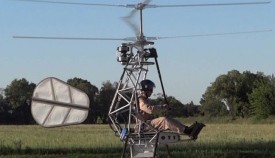World's first untethered, manned electric helicopter flight
on

On August 12, electrical/aerospace engineer and helicopter pilot Pascal Chretien took to the air in the world's first untethered, fully electric manned helicopter flight in a prototype machine that he designed and built almost entirely by himself within a 12 month development period. In his 2 minute, 10 second test flight, Chretien beat aviation giant Sikorsky into the record books -- but it was not without significant risk. As the man himself puts it: "in case of crash I stand good chances to end up in kebab form."
With battery technology advancing steadily and electric vehicles popping up across all sorts of transport modes, electric helicopters have been one of the last dominoes to fall. That's because the dynamics of helicopter flight tend to consume a lot of energy -- and in a way that doesn't fit in well with the way batteries perform.
So when French company Solution F contacted Pascal Chretien and asked him to build the world's first manned electric helicopter, he knew he had to come up with a pretty unique design -- an ultra-light, super simple helicopter that could get a decent flight time out of its available battery power.
For the basics of conventional helicopter flight and definitions of a couple of the terms below, check out our "How to Fly a Helicopter" video - it really is fascinating how these contraptions work in a conventional sense.
A conventional system wouldn't work here though - a tail rotor, for example, drains somewhere between 8% and 10% of total hover power. So Chretien modeled and built a coaxial design with two counter-rotating rotors on top - a torque-balanced design that can fly without the need for a tail rotor to stop the aircraft rotating out of control - instead, it just needs a simple, lightweight tail fin.
In place of the typical cyclic control, which uses an ingenious variable blade tilting system to control which way the helicopter tilts and advances, Chretien chose an extremely simple weight-shifting system -- a big set of handlebars (incorporating the collective control) that literally tilt the main weight of the aircraft underneath the rotors -- as his steering assembly. But this increased Chretien's risk factor by a significant margin -- because it meant the controls would be reversed compared to a normal helicopter.
Yaw control was achieved with a combination of electric controllers (presumably varying the speeds of the two rotors) and a mechanical linkage that tilts the tail fin against the downwash from the main rotors -- and the yaw controls are operated through pedals as in a conventional helicopter design.
The frame of the helicopter was built from welded 7020 aluminum tubing -- composite materials would have been lighter, but time was of the essence, and crash-worthy aluminum frames can be built in very short timeframes -- plus, this decision helped keep the cost of the vehicle down.
Chretien had been given a target of 10 to 12 minutes' flight time by Solution F, so the most critical part of the aircraft design was working out how to store enough power for this kind of flight, as well as how to use that power most efficiently. Early on, he sought the help of Lithium Balance, who supplied the battery management system and consulted on power storage issues. Chretien chose brushed DC motors for the rotor shafts, even though the required power output was "just on the edge of what can be achieved with brushed motors" -- because brushed motors are exceptionally efficient, and their simple controller units are significantly lighter than those of more powerful, less efficient brushless motors. With these in place, Chretien was able to achieve an 87.5% energy efficiency between the battery terminals and the rotor shafts.
Source: Gizmag


Discussion (0 comments)